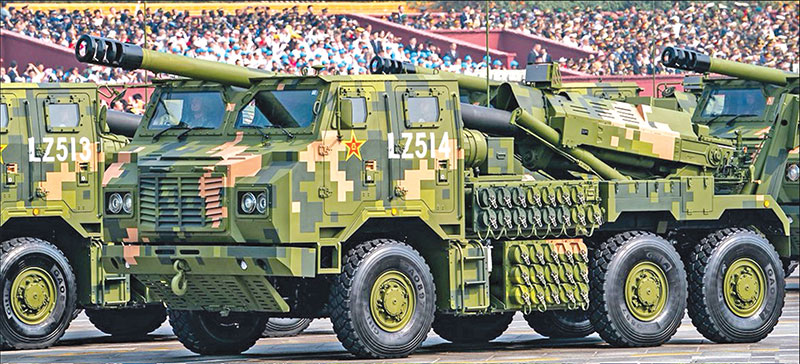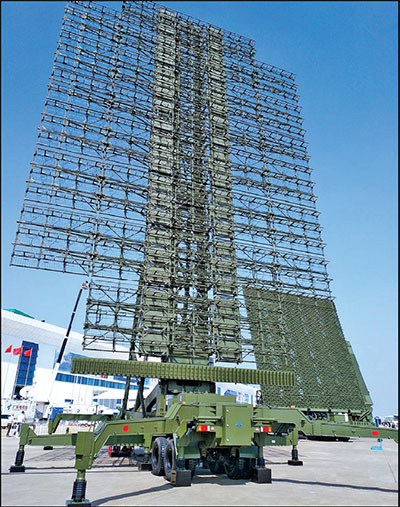India lags behind Pakistan in its acquisition of crucial smart projectiles
Prasun K. Sengupta
Pakistan has yet again proven to be China’s most valued customer. This is for the latter’s home-grown military hardware through its latest procurement of a sizeable package that comprises 236 22-tonne SH-15 155mm/52-calibre mounted gun system (MGS), along with GP-155B GPS-guided projectiles and Sky Saker FH-500 tactical-recce unmanned aerial systems (UAS). The USD512 million contract for this package was inked on June 27 this year between the Pakistan Army (PA) and China North Industries Corp (NORINCO) for equipping 12 medium field artillery regiments of the former. In addition, a separate contract was signed for upgrading the PA’s 268 Type 85-IIAP main battle tanks (MBTs) that were procured back in the early Nineties.

The SH-15 is the export designation of the PCL-181 MGS, with started entering service with an independent artillery regiment of the People’s Liberation Army Ground Force (PLAGF) in the Western Theatre Command’s Tibet Military District back in mid-2017 and has since also entered service with the artillery brigades of the PLAGF’s 71st, 72nd (9th Artillery Brigade, or Unit-73031) and 77th Group Armies. The SH-15 had made its international debut at the 10th international defence exhibition and seminar (IDEAS), which was held from November 27-30 last year at the Karachi expo centre (see FORCE January 2019 pages 46-49). The PA, whose present-day holdings of medium and heavy field artillery assets include 40 M-110A2 tracked 203mm howitzers, 152 M-109A2 and 115 M-109A5 tracked howitzers, 124 M-198 towed 155mm/39-cal howitzers, 72 Panter towed 155mm/52-cal howitzers, 87 type 59-1 130mm towed and 179 D-30 122mm towed howitzers, has been on the lookout for motorised 155mm/52-cal MGS for the past 18 years that are meant as replacements for the Type 59-1 and D-30 howitzers.
The SH-15, which will be licence-assembled by Pakistan’s state-owned Heavy Industries Taxila (HIT), uses a 6 x 6 wheeled Shaanxi truck chassis with an armoured cabin at the front (that also houses the digital ballistics computer and communications radios) and the AH-2 155mm/52-cal howitzer mounted at the rear. The howitzer has a powered traverse of 25 degrees left and right and powered elevation from 0-degree to 67.5 degrees. The howitzer is protected against firing of small arms and artillery shell splinters. The armoured cab also has two large bulletproof windows at the front and there are two doors on each side. The truck chassis is powered by a 400hp diesel engine with a 15.68hp/tonne power-to-weight ratio.
The SH-15 can fire all NATO-standard 155mm ammunition and it uses a semi-automatic loading system. The barrel is fitted with a double-baffle muzzle-brake and when travelling, the barrel is held in position by a clamp, located to the immediate rear of the cab, which is operated by remote control. When the SH-15 is deployed in the firing position, two large spades are lowered at the rear to provide a stable firing platform. For this, the truck chassis is fitted with a hydro-pneumatic suspension system. The SH-15 has a minimum firing range of 20km and 53km with a rocket-assisted artillery projectiles. The entire MGS is operated by a crew of five. On each side of the truck chassis, there are storage boxes containing charges and ammunition, elevation and traverse are hydraulic with manual controls being provided as a back-up. Maximum rate of fire is up to six rounds per minute.
The Sky Saker FH-500 UAS is used for beyond-the-horizon target acquisition and forward observation. It, along with the PCL-181 MGS, was showcased for the very first time at the October 1 PLA anniversary parade in Beijing’s Tiananmen Square. The GP-155B GPS-guided projectiles, which made their public debut at the 2014 Airshow China expo in Zhuhai, makes use of China’s Beidou GPS satellite constellation for obtaining terminal course-correction updates.
Another recent procurement by Pakistan from China has been the JY-27A Skywatch-V, a large-scale VHF-band counter-very-low-observable (CVLO) that is closely comparable to Russia’s RLM-M. Developed by East China Research Institute of Electronic Engineering (ECRIEE), part of the China Electronics Technology Group Corp (CETC), the JY-27A was spotted last August at the Pakistan Air Force’s Mianwali air base, which faces Afghanistan. Since India does not possess any type of low-observable manned/unmanned aerial platforms, it is, therefore, obvious that such a radar will be employed for monitoring the movements of any US-operated stealthy aerial platform/s that could attempt unauthorised ingress into Pakistani airspace, as was the case in May 2011 when Op Neptune’s Spear was conducted in Abbottabad. The Pakistan Navy, on the other hand, had last year inducted into service the NORINCO-supplied Sharp Eye tactical UAS for use along the contested Sir Creek area bordering India’s state of Gujarat and Pakistan’s Sindh province.

Meanwhile, utterly frustrated by the long gestation period for developing the GPS-guided Pinaka-2 multi-barrel rocket launch system (MBRL), the Indian Army’s (IA) HQ Northern Command last July began the process of procuring an initial 1,200 Raytheon Missile Systems/Sweden-based BAE Systems Bofors-developed M982 Excalibur GPS-guided cargo projectiles, which will be used by the Indian Army’s (IA’s) Hanwha Techwin/Larsen & Toubro K-9 Vajra (Thunderbolt) 155mm/52-cal tracked self-propelled howitzers and the BAE Systems/Mahindra Defence M-777 ultralightweight field howitzers. The order for the M982 Excalibur rounds was fast-tracked under the emergency powers to the Vice-Chief of the Army Staff at IA HQ, with deliveries commencing last October and all 1,200 rounds have been delivered as of now.
The standard M982 Excalibur is an extended-range guided projectile that uses a combination of a high-glide ratio lifting-body airframe and tightly coupled GPS/MEMS-based inertial measuring unit (GPS/IMU) guidance (developed by Honeywell) to achieve ranges of up to 40km from existing 155mm/39-cal howitzers, with a circular error probable (CEP) of less than 2 metres. Excalibur is fully qualified in multiple artillery systems, including the K-9 and M-777 howitzers. The tightly coupled GPS/MEMS-based IMU increases hit-accuracy and minimises collateral damages to improve the fire-assault efficiency when complex terrain limits the effectiveness of conventional projectiles and makes it difficult in term of logistics and supply.
A major challenge is for the IMU that has to operate at full accuracy even after the extremely harsh launch environment. Hence, the Excalibur uses Colibrys-developed (a subsidiary of France’s SAFRAN Group) accelerometers, is capable, after an initial launch characterised by a gun hard shock of about 20,000 G, to be guided by a GPS receiver and/or an IMU to the target within a precision of 2 metres. The GPS receivers of the Excalibur are optimised for using coordinates supplied by India’s NavIC/IRNSS GPS satellite constellation.
You must be logged in to view this content.

